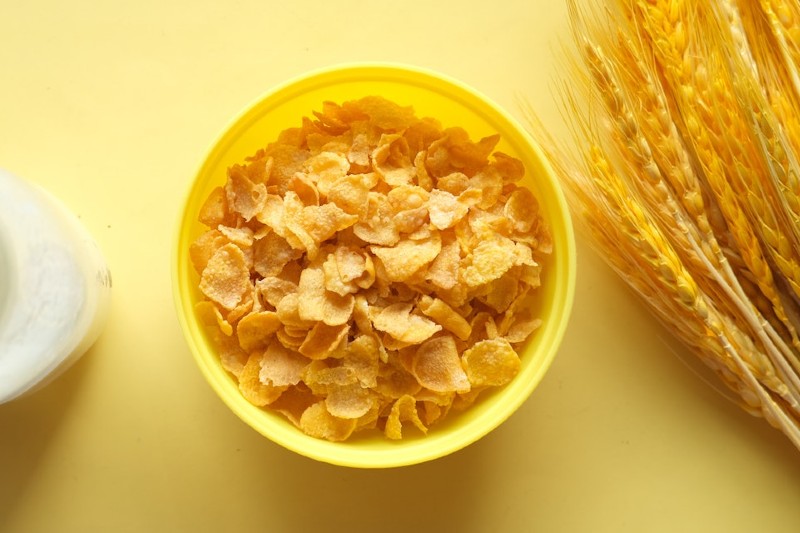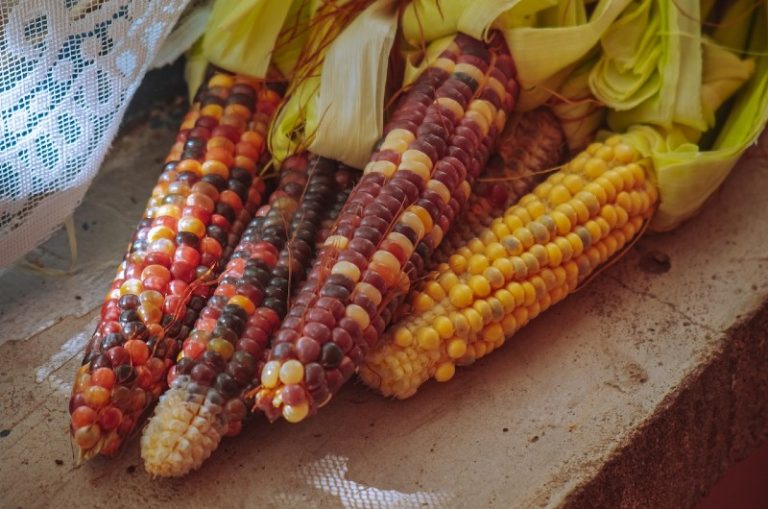Corn No More: Best Wholesome Substitutes for a Fresh Breakfast Start
Corn flakes have long held a prominent place on breakfast tables worldwide, cherished for their convenient crunch and simplicity. However, as dietary preferences and health awareness continue to evolve, the quest for alternatives to traditional corn flakes has gained momentum. This article delves into a diverse array of substitutes that not only cater to various dietary needs but also offer exciting flavors and textures to elevate your morning routine.
Grain-Based Alternatives
Rolled Oats
Rolled oats, often hailed as a nutritional powerhouse, stand as a wholesome alternative to traditional corn flakes. These whole grains undergo minimal processing, retaining their natural nutritional value and offering a wide array of health benefits.
Nutritional Benefits and Fiber Content
Rolled oats are a fantastic source of dietary fiber, which aids digestion, regulates blood sugar levels, and promotes a feeling of fullness. This high fiber content also supports heart health by helping to lower cholesterol levels. In addition to fiber, oats contain vitamins such as thiamin and minerals like magnesium and iron.
Various Ways to Prepare Rolled Oats as a Cereal
- Classic Oatmeal: Cook rolled oats with water or milk for a creamy and warming oatmeal bowl. Customize with toppings like fresh fruits, nuts, seeds, and a drizzle of honey.
- Overnight Oats: Mix rolled oats with your choice of milk, yogurt, and sweetener, and let it sit in the refrigerator overnight. Wake up to a ready-to-eat, chilled cereal with endless topping possibilities.
- Oat Parfaits: Layer rolled oats with yogurt, fruits, and nuts in a glass or jar for a visually appealing and nutritious breakfast.
Whole Wheat Flakes
Whole wheat flakes emerge as a hearty and nutritious substitute for traditional corn flakes, providing a rich source of essential nutrients and a satisfying crunch.
Advantages of Whole Grains for Heart Health
Whole wheat flakes are derived from whole grains, which include the bran, germ, and endosperm, offering a higher nutrient content compared to refined grains. These grains are associated with a reduced risk of heart disease due to their fiber content, antioxidants, and micronutrients.
Comparing Whole Wheat Flakes to Corn Flakes
- Fiber Boost: Whole wheat flakes typically contain more dietary fiber than corn flakes, aiding in digestion and promoting a feeling of fullness.
- Nutrient Diversity: Whole wheat is rich in B-vitamins, such as folate and riboflavin, along with minerals like magnesium and zinc.
- Sustained Energy: The complex carbohydrates in whole wheat provide steady energy release, avoiding the rapid blood sugar spikes associated with sugary cereals.
Quinoa Flakes
Quinoa flakes, derived from the nutrient-rich quinoa seed, present an innovative and protein-packed alternative to corn flakes. These flakes offer a unique texture and a range of health benefits.
High Protein and Amino Acid Profile
Quinoa is known for being a complete protein source, containing all nine essential amino acids that our bodies require. This makes quinoa flakes an excellent choice for vegetarians and vegans looking to increase their protein intake.
Cooking Techniques and Flavor Variations
- Hot Quinoa Cereal: Similar to oatmeal, cook quinoa flakes with water or milk for a warm and nourishing cereal. Add spices like cinnamon, nutmeg, or vanilla for extra flavor.
- Cold Quinoa Breakfast Bowl: Mix quinoa flakes with yogurt or milk, and layer with fresh fruits, nuts, and a drizzle of honey for a refreshing and protein-packed breakfast.
Gluten-Free Substitutes
Rice Flakes
For those with gluten sensitivities or celiac disease, rice flakes stand out as a safe and versatile alternative to traditional corn flakes. These delicate flakes offer a neutral taste and can be used in various ways to create a wholesome breakfast.
Celiac-Friendly and Easily Digestible
Rice flakes are naturally gluten-free, making them a suitable choice for individuals who need to avoid gluten. They are gentle on the digestive system and less likely to cause discomfort for those with sensitive stomachs.
Incorporating Rice Flakes into the Diet
- Simple Rice Flakes Cereal: Combine rice flakes with your preferred milk or dairy-free alternative. Enhance the flavor with sliced bananas, berries, or a sprinkle of cinnamon.
- Rice Flakes Porridge: Cook rice flakes with water or milk until they soften and form a porridge-like consistency. Add dried fruits, nuts, and a drizzle of maple syrup for sweetness.
Millet Flakes
Millet flakes emerge as a nutritious and gluten-free substitute for corn flakes, offering a delightful crunch and a range of health benefits.
Nutrient Richness and Gluten-Free Attributes
Millet, a naturally gluten-free grain, is rich in essential nutrients such as magnesium, phosphorus, and B-vitamins. Millet flakes retain these nutritional benefits, making them a wholesome option for those with gluten sensitivities.
Flavor Nuances and Recipe Ideas
- Millet Flakes Breakfast Bowl: Combine millet flakes with your favorite milk or yogurt. Add fresh fruits, nuts, and a drizzle of honey or maple syrup to create a balanced and flavorful breakfast bowl.
- Millet Flakes Granola: Mix millet flakes with nuts, seeds, and a touch of coconut oil and honey. Bake until golden brown for a gluten-free granola perfect for snacking or topping your morning yogurt.
Buckwheat Flakes
Buckwheat flakes, derived from the nutrient-rich pseudocereal, provide a distinctive and gluten-free alternative to traditional corn flakes. These flakes boast unique health benefits and a rich, nutty flavor.
Unique Seed-Based Composition
Despite its name, buckwheat is not related to wheat and is naturally gluten-free. It’s rich in antioxidants, vitamins, and minerals, making buckwheat flakes a nutrient-dense choice for those seeking gluten-free options.
Exploring Buckwheat Flakes in Breakfast Recipes
- Buckwheat Flakes Porridge: Cook buckwheat flakes with milk or water until they reach a creamy consistency. Top with sliced fruits, a sprinkle of seeds, and a drizzle of honey for added sweetness.
- Buckwheat Flakes Crunch: Use buckwheat flakes as a base for a homemade cereal mix. Combine with dried fruits, nuts, and a touch of cinnamon for a satisfying and crunchy morning meal.
Paleo and Low-Carb Substitutes
Buckwheat Flakes
Buckwheat flakes, derived from the nutrient-rich pseudocereal, provide a distinctive and gluten-free alternative to traditional corn flakes. These flakes boast unique health benefits and a rich, nutty flavor.
Unique Seed-Based Composition
Despite its name, buckwheat is not related to wheat and is naturally gluten-free. It’s rich in antioxidants, vitamins, and minerals, making buckwheat flakes a nutrient-dense choice for those seeking gluten-free options.
Exploring Buckwheat Flakes in Breakfast Recipes
- Buckwheat Flakes Porridge: Cook buckwheat flakes with milk or water until they reach a creamy consistency. Top with sliced fruits, a sprinkle of seeds, and a drizzle of honey for added sweetness.
- Buckwheat Flakes Crunch: Use buckwheat flakes as a base for a homemade cereal mix. Combine with dried fruits, nuts, and a touch of cinnamon for a satisfying and crunchy morning meal.
Almond Meal
Almond meal, derived from finely ground almonds, presents a nutrient-dense and low-carb alternative to corn flakes. It’s a versatile ingredient that can be used to create both cereal and a range of baked goods.
Protein Density and Low-Carb Nature
Almond meal is not only rich in protein but also low in carbohydrates, making it an ideal choice for those following a low-carb or paleo diet. Protein promotes satiety and helps maintain muscle mass, contributing to a balanced breakfast.
Baking Applications and Porridge Recipes
- Almond Meal Cereal: Mix almond meal with a small amount of berries and nuts for a simple, no-cook cereal option. Drizzle with almond milk and a touch of honey for added moisture and flavor.
- Almond Meal Porridge: Cook almond meal with almond milk and a pinch of cinnamon for a creamy and satisfying low-carb porridge. Top with sliced almonds and a dollop of almond butter for extra nuttiness.
Chia Seed Pudding
Chia seed pudding, a creative and nutritious alternative to traditional corn flakes, is a popular choice among those seeking paleo and low-carb options. This gel-like pudding offers a unique texture and a wealth of health benefits.
Gel-Like Texture and Omega-3 Fatty Acids
Chia seeds, when soaked in liquid, expand and create a gel-like texture. This unique quality gives chia seed pudding its characteristic consistency. Additionally, chia seeds are rich in omega-3 fatty acids, which support heart health and brain function.
Creating Chia Seed Pudding with Various Toppings
- Basic Chia Seed Pudding: Combine chia seeds with a liquid of your choice, such as almond milk or coconut milk. Let the mixture sit in the refrigerator overnight to thicken. Top with fresh fruits, nuts, and a drizzle of honey or maple syrup.
- Layered Chia Parfait: Alternate layers of chia seed pudding with dairy-free yogurt and layers of berries for a visually appealing and satisfying breakfast parfait.
Innovative Plant-Based Choices
Quinoa Clusters
Quinoa clusters bring a delightful crunch and protein-packed punch to the world of corn flakes substitutes. These clusters offer a unique texture and a variety of flavor possibilities.
Crunchy and Protein-Packed Clusters
Quinoa, when baked with a touch of sweetener, forms clusters that are irresistibly crunchy. These clusters are not only satisfying but also provide a protein boost, making them a substantial breakfast choice.
Making Quinoa Clusters at Home
- Quinoa Cluster Base: Mix cooked quinoa with a binding agent such as nut butter, honey, or maple syrup.
- Customizable Add-Ins: Fold in a variety of nuts, seeds, dried fruits, and spices to create a diverse flavor profile.
- Baking Process: Spread the mixture on a baking sheet and bake until golden brown. Once cooled, break into clusters.
Nut and Seed Mixes
Nut and seed mixes offer a customizable and nutrient-dense alternative to traditional corn flakes. These blends provide a plethora of flavors, textures, and essential nutrients.
Customizable Blends for Diverse Nutrients
Creating your own nut and seed mix allows you to tailor your breakfast to your preferences and nutritional needs. These mixes often combine a variety of nuts, seeds, and sometimes dried fruits for a balanced and flavorful experience.
Incorporating Dried Fruits and Spices
- Flavor Variety: Add dried fruits like raisins, cranberries, or apricots for natural sweetness and a burst of flavor.
- Spice Infusion: Enhance the mix with spices such as cinnamon, nutmeg, or cardamom for a warming touch.
Serving Suggestions
Enjoy your nut and seed mix as a standalone snack, sprinkle it over yogurt or smoothie bowls, or combine it with milk for a textural breakfast experience.
Legume Flakes
Legume flakes, sourced from nutrient-dense lentils and chickpeas, present a creative and protein-rich alternative to traditional corn flakes. These flakes offer a savory twist and a boost of plant-based goodness.
Lentil and Chickpea-Based Options
Lentil and chickpea flakes are derived from legumes, which are known for their high protein content, fiber, and various vitamins and minerals. These flakes provide a satiating and nutrient-packed breakfast option.
Nutritional Benefits and Savory Recipes
- Protein Powerhouse: Legume flakes provide plant-based protein that supports muscle maintenance and overall well-being.
- Savory Applications: Experiment with savory breakfast bowls by mixing legume flakes with sautéed vegetables, herbs, and a drizzle of olive oil.
Homemade Substitutes
DIY Granola
Crafting your own granola is a rewarding way to have full control over your breakfast ingredients, ensuring a nourishing and flavorful start to your day.
Controlling Sugar Content and Ingredients
Homemade granola allows you to regulate the amount of added sugars and choose wholesome ingredients. This gives you the freedom to create a breakfast option that aligns with your dietary preferences.
Granola as a Versatile Cereal Replacement
- Crispy Texture: Baking oats, nuts, and seeds results in a satisfyingly crunchy texture that pairs well with milk or yogurt.
- Customizable Flavors: Experiment with different flavor profiles by adding dried fruits, spices, and even a touch of natural sweeteners like honey or maple syrup.
Breakfast and Beyond
Enjoy your homemade granola not only as a cereal but also as a topping for smoothie bowls, yogurt parfaits, or as a crunchy snack on its own.
Toasted Muesli
Toasted muesli offers a hearty and minimally processed alternative to traditional corn flakes. This homemade cereal combines whole grains, nuts, and dried fruits for a balanced and satisfying breakfast.
Minimal Processing and Whole Ingredients
Toasted muesli is made from whole, unprocessed ingredients, preserving their natural flavors and nutritional benefits. This ensures that you’re nourishing your body with wholesome nutrients.
Flavor Combinations and Preparation Tips
- Grain Base: Combine rolled oats, nuts, seeds, and dried fruits in a mixing bowl.
- Toasting Process: Lightly toast the mixture in the oven until golden brown and fragrant.
- Serving Suggestions: Enjoy toasted muesli with milk, yogurt, or as a topping for smoothie bowls.
Balanced and Nutrient-Rich Breakfast
Toasted muesli offers a combination of complex carbohydrates, healthy fats, and dietary fiber that provides sustained energy and keeps you feeling satisfied throughout the morning.
Customized Cereal Blends
Crafting your own customized cereal blends allows you to create a breakfast that perfectly suits your taste preferences, dietary needs, and nutritional goals.
Mixing Grains, Nuts, Seeds, and Dried Fruits
By combining a variety of grains such as oats, quinoa flakes, and rice flakes with nuts, seeds, and dried fruits, you can design a cereal blend that offers a diverse range of textures and flavors.
Portion Control and Creative Breakfast Solutions
- Portion Size: Prepare your cereal blend in batches to easily portion out servings.
- Versatile Usage: Enjoy your customized cereal blend with milk or yogurt, use it as a topping for smoothie bowls, or even incorporate it into baked goods like muffins and pancakes.
Embracing Creativity
Crafting your own cereal blends encourages experimentation. Consider adding spices, such as cinnamon or nutmeg, or incorporating superfoods like chia seeds or flaxseeds for added nutritional value.





